Before Vietnam was able to produce these two types of drugs, cancer patients had to go abroad if they wanted to use them.
Currently, the Nuclear Research Institute is the only facility in the country utilizing the Dalat Nuclear Reactor to produce radioactive drugs. The radioactive substances being formulated here include I-131 solution and capsules used for diagnosing and treating thyroid disorders (Graves’ disease, thyroid cancer, etc.), P-32 solution for treating pain from bone metastases, P-32 tablet form for treating vascular tumors in children, and Tc-99m attached to specific labeling compounds (MDP: bone imaging; DTPA: kidney imaging; Phytec: liver imaging) for 25 nuclear medicine departments nationwide in the diagnosis and treatment of cancer. Some products are also exported to Cambodia.
Dr. Pham Thanh Minh, Director of the Center for Radioactive Isotope Research and Production at the Nuclear Research Institute, stated that the production process involves irradiating non-radioactive materials in the nuclear reactor to create radioactive materials. Afterward, technicians will perform extraction to obtain the radioactive nuclei of interest, followed by quality control and distribution to hospitals.
There are two types of radioactive drugs with short and long half-lives. In Vietnam, the Hanoi Irradiation Center (HIC) and several hospitals use active accelerator machines to produce radioactive substances with short half-lives for cancer diagnostics. The Nuclear Research Institute mainly produces radioactive substances with long half-lives.

Room for I-131 drug formulation. (Photo: Nuclear Research Institute).
Dr. Minh noted that diagnosing and treating diseases with radioactive drugs is an irreplaceable method for certain cancers today. Currently, the radioactive drugs produced using the Dalat Nuclear Reactor meet about 60% of demand. “The ability to produce radioactive drugs domestically reduces the product price to one-third of that of imports and contributes to the formation and development of the domestic nuclear medicine network,” Dr. Minh explained. However, the Dalat Nuclear Reactor has a low capacity (500 kW) and does not yet meet local demand. Additionally, importing materials for drug production is challenging due to regulations from the Ministry of Health.
The Nuclear Medicine Department at Cho Ray Hospital (Ho Chi Minh City) is one of 25 facilities nationwide using radioactive drugs to treat about 200 patients each month. The hospital currently uses I-131 radioactive drugs from the Dalat Nuclear Research Institute and from abroad to treat thyroid cancers and hyperthyroid conditions like Graves’ disease.
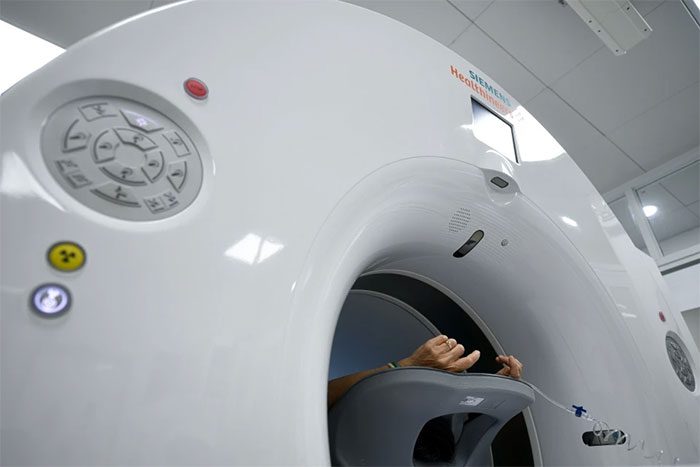
This image shows a patient being placed in the PET/CT scan chamber, which provides highly detailed images of cancer tissues with high accuracy, used at Cho Ray Hospital. Before the PET/CT scan, the patient is injected with a radioactive tracer, an essential substance that helps specialists assess the location and extent of inflammation or cancer cells.
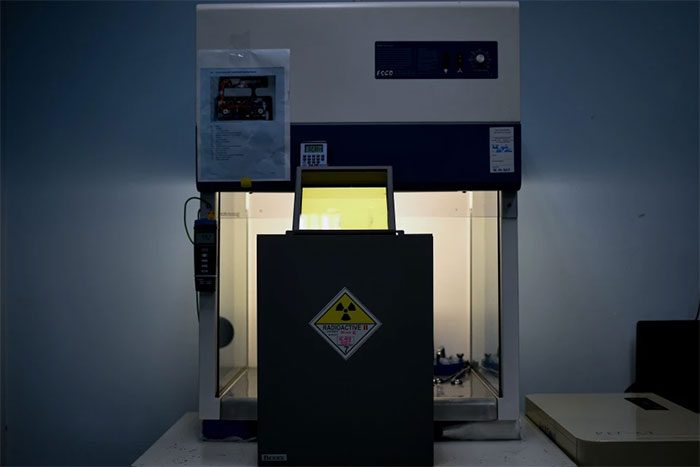
Recently, the Nuclear Medicine Department of the hospital successfully formulated and used two new radioactive tracers named Ga-68 PSMA for prostate cancer and Ga-68 Dotatate for neuroendocrine tumors. Formulating radioactive drugs for PET/CT scanning is a complex task that requires a highly controlled environment to ensure absolute radiation safety.
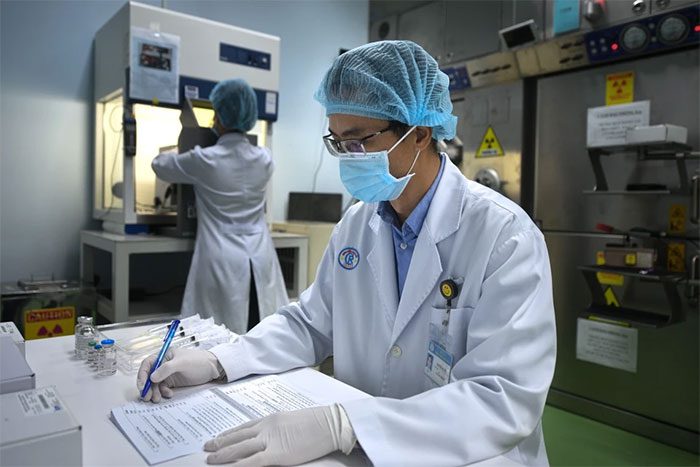
Nuclear physicist Nguyen Tan Chau and radioactive chemist Nguyen Thi Phuong Nam are responsible for formulating these two drugs. Since 2021, this unit has been importing equipment and testing formulations. Previously, they spent many years studying and exchanging experiences. On November 7, nearly three years after much effort, the drugs were officially put into use.

Formulating the drugs involves a series of chemical reactions comprising three stages and 28 steps, taking over 30 minutes. Engineers must continuously monitor the reaction process, gather information, and follow procedures accurately. Each day, the formulation room can produce only 2-4 doses.

Each formulation yields about 15 ml. The drug will be immediately transferred to the PET/CT scanning room to be injected into the patient about an hour before the scan. The advantage of these two drugs in PET/CT imaging is that images of cancer cells will show more detailed biological and metabolic aspects, making it easier to assess and monitor cancer treatment.
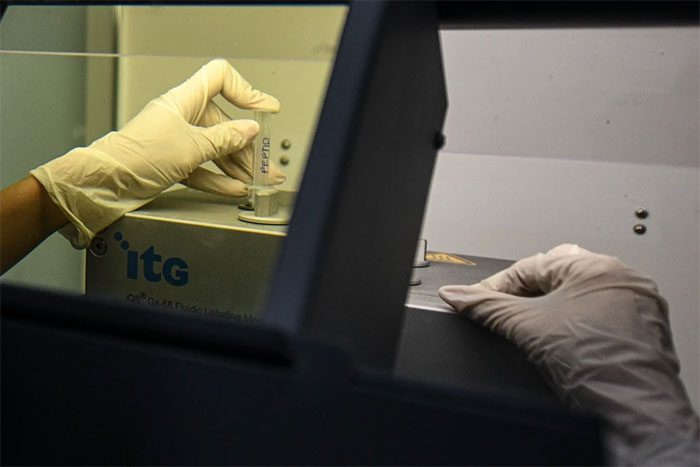
These two drugs have very short half-lives, lasting just over 60 minutes, after which their effectiveness diminishes, making it impossible to import them from abroad. Therefore, patients must travel abroad for their needs. “This is also the reason the department is determined to produce Ga-68 PSMA and Ga-68 Dotatate to serve patients right at the hospital,” stated Dr. Nguyen Xuan Canh, head of the Nuclear Medicine Department.

Engineer Nguyen Tan Chau is checking radiation levels around the formulation machine. This is a continuous task in a high-radiation environment.

This is a model simulating the reaction process. The engineers in the Nuclear Medicine Department study based on this model to experiment with drug formulations.

Radioactive drugs injected into the patient’s vein, allowing PET/CT to provide highly detailed images of cancer tissues with high accuracy. The image shows the results of diagnosing recurrent prostate cancer in a 47-year-old patient who had previously undergone surgery. The bright red spots indicate cancer cells that appeared after reacting with the Ga-68 PSMA drug.
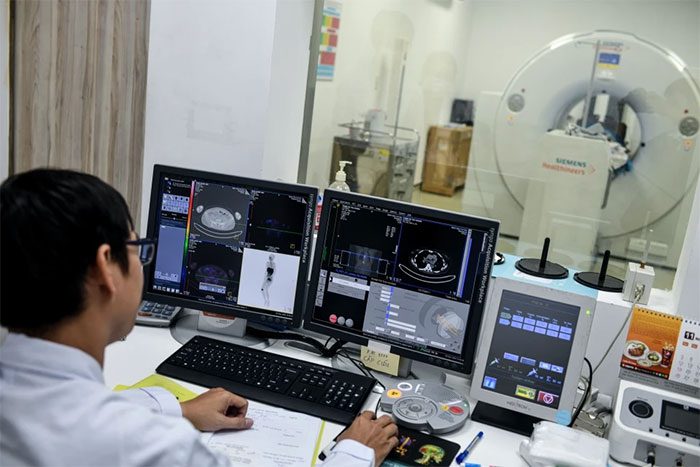
Since the drugs were put into use, Cho Ray Hospital has conducted PET/CT scans to assess and monitor treatment for 12 patients diagnosed with neuroendocrine tumors and 13 patients with prostate cancer. This is seen as a significant advancement for Vietnam, helping patients easily access advanced imaging technology without having to go abroad as before.
Dr. Canh remarked that the current trend is to provide targeted therapy using radioactive drugs for certain conditions such as prostate cancer, bone metastases, hepatocellular carcinoma, and neuroendocrine tumors. He hopes that domestic scientists will research and attach radioactive isotopes to targeted drugs for imaging, assessing the absorption capacity of the drugs to cancer lesions, forming a basis for doctors to make treatment decisions. “Targeted drugs can be supplied to hospitals, potentially reducing treatment costs by over 50%,” Dr. Canh said.
With the anticipated rise in demand for radioactive substances in the near future, the Nuclear Research Institute plans to supplement low-enriched U-235 fuel (19.75%) to enhance the operation of the reactor for producing radioactive substances over the next ten years, aiming to meet approximately 80% of hospitals’ needs domestically and abroad. The Vietnam Atomic Energy Institute is promoting the implementation of the Nuclear Science and Technology Research Center project (NSTRC) with a large 10 MWt nuclear reactor, where the application of the reactor to produce radioactive isotopes for socio-economic development will be a top priority.
The institute also intends to build a strong research team, the leading group in radioactive drugs (at least 10 people), to research and develop practical applications.


















































